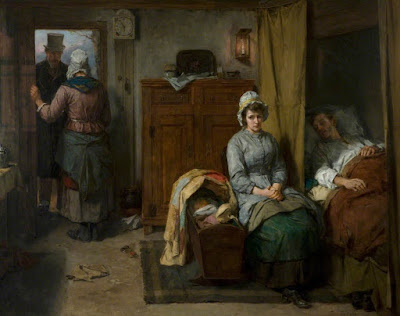Why GPs are leaving , Knitting or Gin and Tonic?
On
Leaving a GP Practice
 |
The Doctor's Visit,Thomas Fahed (1825/6-1900)
Photo Credit: Queen's University Belfast [CC BY-NC-SA]
|
I loved my work as a doctor, but I detested the
bureaucracy of it all. Constant negotiations and contract changes were hard to
understand for someone new to the game, and I found the disconnect between
government agenda and grassroots GP values mind boggling.
We use outdated IT systems and are generally viewed
as the backstop for everybody, taking on responsibility for all health needs of
the public despite not being set up to do so. The Government and health boards
want us to reach targets which are often unrealistic with limited resources.
…I never expected to “burn out”, especially at such
an early stage in my GP journey. But I followed the typical trajectory,
qualifying at the age of 28 and burning myself out at 33.
…The irony was there was never a day in my job when
I didn’t love my core work as a GP. I just hated everything else that came with
it. All I wanted to do was what I studied to do: see patients, help them and go
home. So I chose to do just that, and found my happy place again, working as a
full-time GP locum.
(Dr Punam Krishan, The i, 2019)
How
many times over the years have we heard exactly the same story from both the
medical and teaching professionals: We love the job but loathe the bureaucracy.
Some politicians have eyes but they cannot see, have ears but cannot hear.
Knitting
Last year, looking to find a way of winding down
that didn’t involve listening to free jazz while hoovering up a large gin, I
started knitting.
…I’m not the only one to have cottoned on to the
therapeutic benefits of knitting. The Wall Street Journal reports that Google
has hired “mindful knitting” consultants to help its staff to relax with
“medknitation”. In a recent US survey 94% of 3,000 respondents said that they
knit or crochet as a method of “self-care”. Here, NHS chiefs have suggested
that GPs recommend knitting as lifestyle advice to patients.
…Still, concerned that “mindful knitting” sounds
completely made up, I speak to Danny Hill, a former Buddhist monk, mindfulness
expert and advocate of mindful knitting sessions.…“The rhythm of the knitting is very soothing and it
brings this focus to what you’re doing, so automatically your level of
concentration improves – people feel happy and calm,” he says. “You have the
texture of the wool, the feel of the needles, you may have smell, you also have
sight – all the colour in there. Mindfulness is all about being aware of your
sensory experience all the time…With mindfulness you’re always trying to bring
your mind back to the present, and that will be your knitting. So you start to
notice what’s going on right now. Rather than thinking about, ‘Oh God, the
argument I had yesterday,’ you leave the thought where it is and come back to
the knitting.”
There’s nothing intrinsically wrong with a wandering
mind, but often meandering thoughts turn negative.
…Lynne Rowe, the author of Knit Yourself Calm
teaches similar skills in workshops in Warrington, Cheshire.
“If you’re anxious and stressed and struggling,
doing mindful knitting each day for 20 minutes when you’re focusing on your
breathing and your stitches, the benefit is enormous,” she says.
Rowe’s students start by focusing on their breathing
and physical relaxation, then they might try to focus on a specific sound
outdoors, such as birdsong. After this they practise different stitches. She
also encourages them to choose a shade of wool with happy connotations.
The act of knitting is the perfect companion to this
mindful practice because, she says, “You’re doing the same thing over and over
again. Each stitch will have a little rhythm; maybe you could count as you do
each part of the stitch. You could also have a little mantra. You could say.
‘May I be well, may I be happy,’ over and over until you get to the end of the
row. All the time you’re doing this, you’re trying to combine the breathing
with your stitches.”
(Phil Robinson, The Times, 2019)
Winding down? I think I’d stick to the jazz and gin.
Winding down? I think I’d stick to the jazz and gin.

Comments
Post a Comment